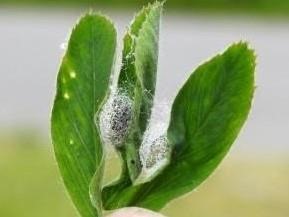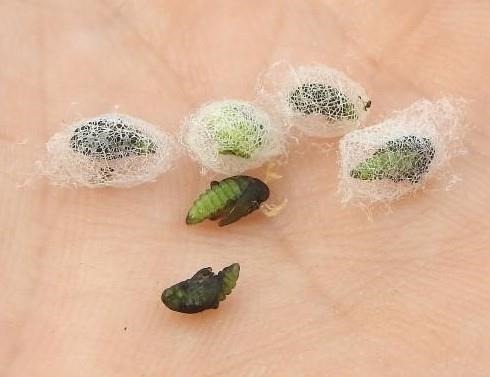By Curtis Young and Andy Michel et.al
The activity and threat of the alfalfa weevil is mostly coming to an end for this year. Observations made in alfalfa fields across Ohio reveal that the alfalfa weevil larvae are finishing their feeding and spinning net-like cocoons in the alfalfa foliage in which to pupate. The pupae are the stage in which this insect goes through metamorphosis into the next adult stage. These adults do little damage to the crop.

Alfalfa leaves with attached alfalfa weevil net-like cocoons.
They feed for a short time, then enter an inactive period called aestivation. They will become active again in late-summer and fall to feed again to prepare to overwinter. Some larvae are still present. These larvae can produce strips of damage under wind rows after the first cutting resulting in browned out strips where the wind rows laid in the field. Once the hay is baled, the larvae will be exposed to predation.

Alfalfa weevil net-like cocoons and exposed alfalfa weevil pupae.
Our next threat to our alfalfa crop production will be potato leafhopper (PLH). Each year, PLH must migrate back into Ohio from the southern states. As our weather patterns shift to movement from the south toward the north, the winds pick up populations of adult PLH and carry them north allowing them to colonize Ohio’s alfalfa fields, soybean fields, clover fields and many other types of plants. This regularly occurs in mid- to late May every year. Once the migrant PLH adults arrive, they begin laying eggs. It only takes about 3 weeks for these eggs to hatch into nymphs and develop into adults. Thus, populations of PLH can rapidly explode into a serious threat to alfalfa production. This is one insect that we can predict will be a serious threat to our crop production almost every year.
New spring seedings of alfalfa can be extremely impacted by the relatively low numbers of PLH and should be scouted regularly (weekly) for PLH. Action thresholds can be exceeded very fast in these slow growing new stands. Once damaged, PLH can impact their growth for the rest of the year.
Older stands can tolerate higher numbers of PLH, but as the second-cut alfalfa grows, producers should be scouting regularly for increasing PLH populations in their fields. Proper scouting must be done with a standard-sized sweep net. For a video on scouting techniques visit: https://forages.osu.edu/video/scouting-potato-leafhopper-alfalfa
If alfalfa is more than seven days from a cut and plants are under normal stress, a good rule of thumb for an action threshold for treatment is when the number of PLH (nymphs+adults) in a 10-sweep set is equal to or greater than the height of the alfalfa. For example, if the alfalfa is 10 inches tall, and the average number of PLH per sample is 10 or higher, treatment is warranted. If the average is nine or lower, the grower should come back within a few days to see if the population is continuing to increase (treatment warranted), staying the same (come back again in a few days) or declining (treatment not warranted). Vigorous alfalfa can tolerate higher numbers, and stressed alfalfa can tolerate fewer, so you may need to adjust your action threshold based on the condition of the alfalfa.
Source : osu.edu